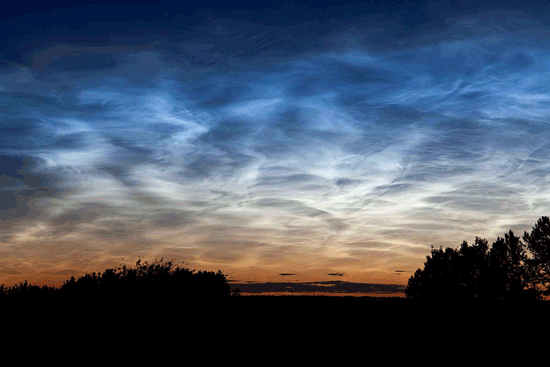By Diane K. Fisher
The sky has to be clear to see them. They are wispy clouds that glow in the dark sky for a while after the Sun goes down. They are called noctilucent clouds. Noctilucent means “night glowing.”
These clouds are too faint to see during the day. The twilight sky gives a dark background to their delicate white or slightly blue wisps. And the Sun, having set below the horizon, still shines through the upper atmosphere where these clouds form and sets aglow their tiny ice crystals.
Even the highest cumulonimbus, or thunder storm clouds, are not found above about 12 miles high. Passenger jets fly under about 7 miles high. But noctilucent clouds are about 50 miles high! This part of the atmosphere is called the mesosphere. It is the coldest region on or near Earth!
In order to turn into a water drop or an ice crystal, water vapor needs a little particle of dust to condense around. What kind of dust floats up that high? And how does the water get up that high to make ice crystals?
Although noctilucent clouds are still somewhat of a mystery, scientists think that some of the tiny particles could be small meteors from space that have burned up in Earth’s upper atmosphere. They leave behind tiny particles of soot and dust. Another source of particles is erupting volcanoes. Their ash is so fine that some of it could well float up to that altitude.
Now, what about the water? How did it get way up there? There is very little water in that part of the atmosphere. It’s much drier than the Sahara Desert! But some water could have come from methane, volcanoes, and rising from lower in the atmosphere. The greenhouse gas methane is a source because it can react with other things in the atmosphere and produce water at this high altitude. Methane is produced by both natural activities (like rotting plant material) and human activities (like dairy farming, with all its burping cows).
In the Northern Hemisphere, noctilucent clouds are most often seen in the summer from mid-May to mid-August. They are most often seen at higher latitudes. In North America, that would be the northern USA and Canada, although they have been spotted as far south as Utah.
If you are looking for noctilucent clouds in August, you can also look for the Perseid meteor shower August 12 and 13. If you are lucky, perhaps you will see both amazing events on the same night! Learn more about observing meteor showers at NASA’s The Space Place.

Noctilucent clouds are made of ice crystals very high in the atmosphere, far above all other clouds. These were photographed nearEdmonton, Alberta Canada on July 2, 2011. Credit: NASA/Dave Hughes
